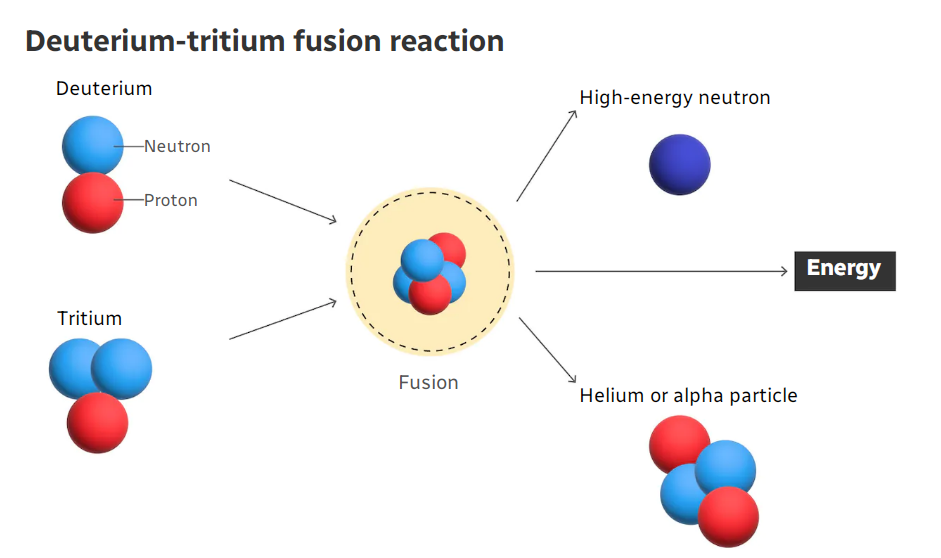What is nuclear fusion and why is it such a big deal?
 The U.S. Department of Energy on Tuesday announced a breakthrough in nuclear fusion, a method of producing clean energy, that has many people hopeful for the future.
The U.S. Department of Energy on Tuesday announced a breakthrough in nuclear fusion, a method of producing clean energy, that has many people hopeful for the future.
The achievement was reached by scientists at the Lawrence Livermore National Laboratory in California.
Nuclear fusion may be a new concept to many, but scientists have been working on it since the 1940s. However, they have faced a tough challenge: how to produce more energy than it takes to create it. It almost seemed like an insurmountable challenge.
Until today.
What is nuclear fusion?
Nuclear fusion is a process where two lighter elements combine to make a heavier element.
It’s the same process that powers our sun, where protons of hydrogen atoms collide violently and at incredibly high temperatures at the core, fusing together to produce a helium atom.
Here on Earth, nuclear fusion is produced by fusing the elements deuterium and tritium. Deuterium is quite plentiful and can be found in water, but is most abundant in our oceans. Tritium, on the other hand, is less plentiful and is primarily found in our atmosphere, a result of cosmic radiation. Tritium is also made in nuclear explosions and is a byproduct from nuclear reactors.
The sun’s massive gravitational force allows it to fuse hydrogen atoms, but to create fusion on Earth, scientists need to apply extremely high pressures and temperatures that are roughly 100 million degrees Celsius, or 10 times hotter than the sun’s core.
While there are different ways to try to produce nuclear fusion, scientists at the California lab used 192 lasers focused on the inner wall of a cylinder that contained a small capsule (about the size of a BB) of fusion fuel: deuterium and tritium.
That generated X-rays from the wall that struck the capsule, squeezing the fuel. It stayed hot, dense and round enough for long enough that it ignited, producing more energy than the lasers used.

While the energy produced was small — about three megajoules, or enough to power a light bulb — it marks a historic first in nuclear fusion energy because the lasers used just over two megajoules to fire into the target.
However, it’s important to note that 300 megajoules of traditional energy — often referred to as “from the wall” energy — were needed to produce all the materials used in the experiment, according to Marv Adams, deputy administrator for Defense Programs at the Nuclear Security and National Nuclear Security Administration.
How is it different from nuclear power we already use?
When most people think about nuclear energy, they likely think about the nuclear reactors we have today. But those reactors operate using nuclear fission.
Fission is the exact opposite of fusion, which forces atoms together. Instead, nuclear reactors generate energy by separating heavy atoms.
As well, fusion produces clean energy. Unlike nuclear reactors, the process doesn’t result in byproducts like the spent rods found in nuclear power plants.
With nuclear fusion, there is also no chance of a nuclear meltdown as there is with fission, and nuclear fusion cannot be used to make nuclear weapons.
The International Atomic Energy Agency explains that while hydrogen bombs do use fusion reactions, a second fission bomb is needed to detonate it.
Why is nuclear fusion important?
Earth is facing a climate crisis caused by centuries of burning fossil fuels. As a result, there will be an increase in floods, droughts, rising sea levels and more. We are already seeing this happening, and the more the planet warms, the worse these disasters will become.
The planet has warmed by roughly 1.2 C, but if we are to limit that to 1.5 C by the end of the century, which is the ambitious goal set at the 2015 Paris climate accord, it could mean fewer climate-related disasters. So, scientists and engineers have been trying to develop cost-effective, clean energy.
That’s where fusion comes in.
It produces no harmful carbon dioxide or methane emissions and is highly efficient.
According to the International Atomic Energy Agency, “Fusion could generate four times more energy per kilogram of fuel than fission (used in nuclear power plants) and nearly four million times more energy than burning oil or coal.”
“It moves us closer to the possibility of zero carbon abundant fusion energy powering our society,” said U.S. Secretary of Energy Jennifer M. Granholm at Tuesday’s announcement.
When will we use fusion as an energy source?
While this is an historic first, it doesn’t mean that we’re ready to produce energy on a large scale yet.
“There are very significant hurdles, not just in the science, but in technology,” said Kim Budil, director of the Lawrence Livermore National Laboratory in Livermore, Calif.
“This is one igniting capsule, one time and to realize commercial fusion energy, you have to … produce many, many fusion ignition events per minute and you have to have a robust system of drivers to enable that,” said Budil.
She explained that though it wouldn’t take quite as long as scientists used to estimate, it will be least a few decades before the underlying technologies are developed enough to build a nuclear fusion power plant.
It’s also important to remember that the U.S. isn’t the only country working on nuclear fusion.
In France, there is the collaborative International Thermonuclear Experimental Reactor, a massive nuclear fusion reactor weighing 23,000 tonnes and standing nearly 30 metres tall, which is set to begin operations in roughly a decade.
In Canada, there are also private companies like General Fusion, based out of British Columbia, among others. There are also private enterprises working on fusion in China, the United Kingdom and Germany.
You can return to the main Market News page, or press the Back button on your browser.

